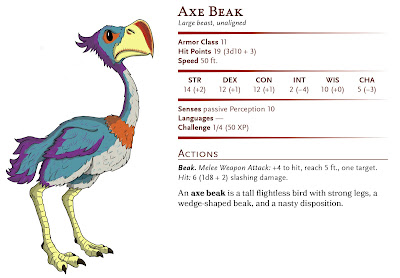D&D Basic Monsters: Flying Sword
Eldecrynn
Tuesday, December 23, 2014
5th edition
,
Bestiary
,
DnD Basic Rules
,
Monsters
No comments
Animated objects, here in the form of a Flying Sword, have probably been with the game since the start (and not just as golems and undead). In original Player's Handbook, the spell Animate Object was part of a cleric's repertoire (as a 6th-level spell), but in 5th edition, the spell is no longer available for clerics, instead being part of the bard, sorcerer and wizard's spell lists.
D&D Basic Monsters: Axe Beak
The Axe Beak appeared in the original Monster Manual, and was one of the first monsters you'd see when you opened the book. They're inspired by prehistoric, flightless birds (related to today's ostriches, emus and rheas), and the massive beak might evoke images of the Gastornis, that lived some 56-45 million years ago. Other gigantic flightless birds have existed, notably on Madagascar, where the Elephant Birds lived, probably up until the 17th or 18th century, the largest of which grew up to 10 feet tall.
D&D Basic Monsters: Mastiff
Today's monster is not of the fantastic sort, but a mastiff - a large guard dog. The drawing is loosely based on a mix between a Bull Masiff and an English Mastiff. Not a timid little lapdog, these magnificent beasts normally weigh between 70 and 90 kg (150 to 200 lbs.), with a shoulder height of roughly 75 cm (30 inches). Their use as guard and war dogs might go back as far as Roman or even Assyrian times.Back in 3rd edition the idea of halfling dog riders were quite common (they even had their own prestige class). While it was never really specified what kind of dog these halfling cavaliers used, it would probably have been a fairly big breed, like the masitff or similar.
D&D Basic Monsters: Twig Blight
Eldecrynn
Thursday, December 11, 2014
5th edition
,
Bestiary
,
DnD Basic Rules
,
Monsters
No comments
The Twig Blight made its first appearance in the "Sunless Citadel" - the first published adventure module for 3rd edition. Originally they had poisonous claws, but the poison seems to have disappeared in 5th edition.
They stand approximately 3 1/2 feet tall, have a taste for blood. Apparently they understand common, though they lack the ability to speak. Still, if you listen very carefully, I'm sure you can hear them mutter "I AM GROOT!" in a very low voice.
(The one depicted here is probably more like a "Stick Blight" than a "Twig Blight")
D&D Basic Monsters: Blood Hawk
Blood Hawks appeared first in the 1st edition Fiend Folio. There they're described as having razor sharp beaks, unusually strong talons and the wingspan of an eagle. Blood Hawks supposedly have a fondness for gemstones, often plucked from the bodies of slain enemies, and male Blood Hawks use these gems to adorn their nests in order to attract the attention of female mates.
An interesting thing to note is that the Fiend Folio describes their coloration as "uniform medium grey", whereas the 5th edition rules say they take the name "from its crimson feathers (and aggressive behavior)".
Also appearing here is the raven - probably most often seen as familiars to wizards. Apparently familiars can't make attacks, but they have to defend themselves from time to time.
(Obviously a raven familiar has intellectual capacities far above the common wild variety).
D&D Basic Monsters: Flying Snake
Eldecrynn
Thursday, December 04, 2014
5th edition
,
Bestiary
,
DnD Basic Rules
,
Monsters
No comments
While a fantastical being, they were described as quite real by the Greek historian Herodotus (c 484-425 BC), who claimed they came from Arabia, and every spring they would fly towards Egypt in great numbers. Their progress would however be stopped by sacred birds -ibises- who would kill and eat the snakes barring their entry into Egypt.
Herodotus says "its form is like that of the watersnake; and it has wings not feathered but most nearly resembling the wings of the bat." In that respect, the rendition above is a bit off...
Subscribe to:
Posts
(
Atom
)






























No comments :
Post a Comment